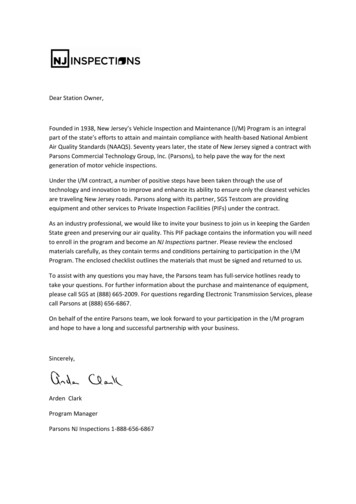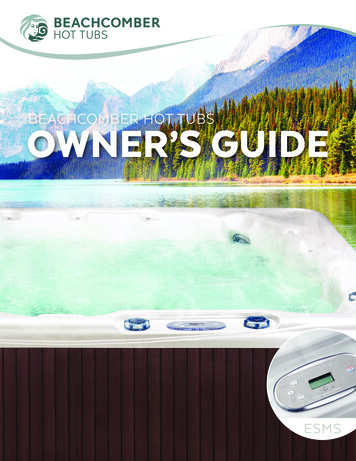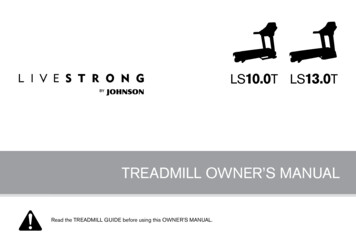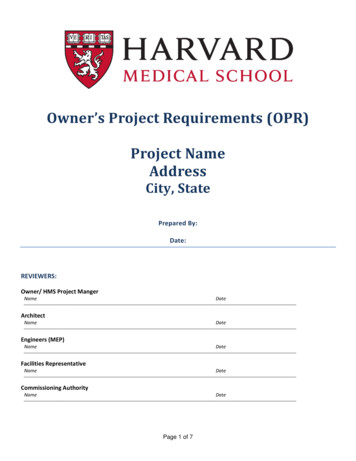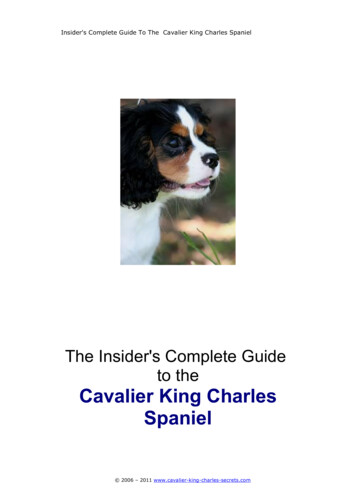
Transcription
Insider's Complete Guide To The Cavalier King Charles SpanielThe Insider's Complete Guideto theCavalier King CharlesSpaniel 2006 – 2011 www.cavalier-king-charles-secrets.com
Insider's Complete Guide To The Cavalier King Charles SpanielTABLEOFCONTENTSTABLEOF CONTENTS.21ALL ABOUT THECAVALIER KING CHARLES SPANIEL.6HISTORY AND EARLY BEGINNINGS OF THE CAVALIER KING CHARLES SPANIEL. 6BREED STANDARDS FOR THE CAVALIER KING CHARLES SPANIEL.8WHAT’S SO SPECIAL ABOUT A CAVALIER KING CHARLES SPANIEL?.112IS A CAVALIER KING CHARLES SPANIEL RIGHT FOR YOU?.14IS A CAVALIER KING CHARLES SPANIEL RIGHT FOR YOU AND YOUR FAMILY?. 14ATTENTION.14FENCEDAREA. OOSING A MALE OR FEMALE DOG. 16MALES.17FEMALES.18SIMILARITIES. 183GETTING A CAVALIER KING CHARLES SPANIEL.19DECIDING ON A PUPPY OR ADULT CAVALIER KING CHARLES SPANIEL. 19THEBENEFITSOFACAVALIERKINGCHARLESSPANIELPUPPY. IEL. 22WHERE TO BUY A CAVALIER KING CHARLES SPANIEL. 22RESCUESHELTERS.23PETSTORES.24BREEDER.24FINDING A GOOD CAVALIER KING CHARLES SPANIEL BREEDER. REEDER?. OU?. 27HOW MUCH WILL A CAVALIER KING CHARLES SPANIEL COST?. 28UNITEDKINGDOM. 29UNITEDSTATES. 29CANADA.29WHATDOESTHEPRICEINCLUDE?.30CHOOSING A HEALTHY CAVALIER KING CHARLES DULTDOG. 32REGISTRIES, REFERRALS AND CONTRACTS. 34CONTRACTS.34 2006 – 2011 www.cavalier-king-charles-secrets.com2
Insider's Complete Guide To The Cavalier King Charles Spaniel4BRINGING YOURCAVALIER KING CHARLES SPANIEL HOME. 36BRINGING HOME A NEW CAVALIER KING CHARLES SPANIEL PUPPY. 36BASICSUPPLIES.37SAFETY. 38TRANSITION.39ATTITUDE.39EXPECTATIONS. 39PREPARING TO BRING HOME A GROWN CAVALIER KING CHARLES SPANIEL DOG.42SUPPLIES. 43PREPARINGYOURHOME. 43WHATTOEXPECT.44INTRODUCING YOUR CAVALIER KING CHARLES SPANIEL TO OTHERS. . 475YOUR NEW DOG’S NEEDS. 49EXERCISING YOUR CAVALIER KING CHARLES SPANIEL. 49AGE.50PHYSICALCONDITION. 50VARIETY. 51DANGEROUSACTIVITIES.52DIET AND NUTRITION BASICS. URCAVALIERKINGCHARLESSPANIEL.54FEEDING YOUR 6HOMECOOKINGFORYOURCAVALIERKINGCHARLESSPANIEL. 56PREMIUMFOODS.576TRAINING YOUR DOG. 59TIPS FOR TRAINING YOUR CAVALIER KING CHARLES SPANIEL. 59MAKETRAININGFUN.60MAKETRAININGNATURAL. 60KEEPTRAININGCONSISTENT. 61PATIENCEISTHEKEY. 61NEVERHITAPUPPY.61GETINAROUTINE.62THE BASICS OF DOG TRAINING. EACHINGYOURDOGTOLAYDOWN.65TEACHINGYOURDOGTOSTAY. 65WALKINGWITHALEASH.66HOUSE TRAINING YOUR PUPPY OR DOG. 67 2006 – 2011 www.cavalier-king-charles-secrets.com3
Insider's Complete Guide To The Cavalier King Charles SpanielCRATETRAINING. 67PAPERTRAINING. 69LITTERBOXTRAINING.70TIPS FOR HOUSE TRAINING AN OLDER CAVALIER KING CHARLES SPANIEL DOG. 707MAINTENANCE OF AHEALTHY DOG. 72GROOMING YOUR CAVALIER KING CHARLES SPANIEL. 72BRUSHING. 72BATHING YOUR CAVALIER KING CHARLES SPANIEL DOG.73EAR CARE FOR DOGS.75GENERALEARCARE.75YEARLYCHECK-UPS. 76CLAW CLIPPING AND CARE FOR CANINES.77CLIPPINGTHENAILS. 77DEWCLAWS. 78VACCINATION REGIMES. 78SIDEEFFECTS.80EXISTINGCONDITIONS. 808MEDICAL CARE OF YOUR DOG. 81PREVENTION IS BETTER THAN A CURE.81DAILYANDWEEKLY. 81WEEKLYTOMONTHLY. 83DENTAL CARE.83TEETH. ICAL CARE INGOMYELIA (SM). ALGLANDS.87SPAYING AND NEUTERING YOUR DOG. 88WHENTOSPAYORNEUTER. 89WHATANIMALSSHOULDBEALLOWEDTOBREED?.90PREGNANCY. EMENT OF COMMON DOG BEHAVIOUR PROBLEMS . 94CONTROLLING UNNECESSARY BARKING.94PUNISHMENT.95TRAINING.95JUMPING. 96PUPPIES.96ADOLESCENTDOGS.97 2006 – 2011 www.cavalier-king-charles-secrets.com4
Insider's Complete Guide To The Cavalier King Charles SpanielBITING AND NIPPING. 98REASONSDOGSBITEORNIP.98TRAININGAPUPPY. 98TRAININGOLDERDOGS.99SEPARATION ANXIETY. ATIONANXIETY.101DIGGING. 102REASONSFORDIGGING.102PREVENTION.103CHEWING AND TEETHING. G RELATED PROBLEMS. 105FOOD. 106DENTALPROBLEMS. 106LACKOFEXERCISE. 106PICA. 107REFUSINGTOEATVS.FINICKYEATERS.107COPROPHAGIA. 108ADULTDOGS.108CORRECTINGTHEPROBLEM.108CONCERNS. 10910THE AGING DOG. 110CARE OF THE AGING DOG. SUMPTION.111BLINDNESSANDHEARINGLOSS. OSS. 112EXERCISE. 112FOODANDWATERANDBEDDING. 113JUMPINGUP.113MANAGINGINCONTINENCE. 113CONCLUSIONS. 115CAVALIER KING CHARLES SPANIEL FAQ. 115SUGGESTED RESOURCES FOR CAVALIER KING CHARLESSPANIELS. .119GENERALDOGSITES. 119 2006 – 2011 www.cavalier-king-charles-secrets.com5
Insider's Complete Guide To The Cavalier King Charles Spaniel1ALL ABOUT THE CAVALIERKING CHARLES SPANIEL Nicolette Neish at IERKINGCHARLESSPANIELThe Cavalier King Charles Spaniel has an interesting, and perhaps one of themost unique histories of any of the spaniel breeds. The first spaniel typebreeds were found in England in the 16th century and were known asComforters. It is believed that they were valued by both the royal courts and 2006 – 2011 www.cavalier-king-charles-secrets.com6
Insider's Complete Guide To The Cavalier King Charles Spanielthe common people as a way to control fleas, as the insects stayed on thedogs instead of biting humans.Charles 1 had a spaniel named Rogue that he kept with him at all times.Charles II is the most famous royalty associated with the King CharlesSpaniel. He, in fact, made it a law that no King Charles Spaniel could bedenied entry into any public building or place. The spaniels were depicted inmany famous works of art showing English royalty during the 16th through 18thcenturies.BreedchangesDuring the late 18th and mid 19th centuries dog breeding and showing becameincreasingly popular in England, and many breeders worked to developdistinctive characteristics in particular breeds. One such breed was the KingCharles Spaniel. Breeders of the day bred the type for a short muzzle, markeddome-shaped head, low set ears and an overall smaller size.In 1926, an American dog enthusiast named Roswell Elderidge challengedthe British breeders to produce a long nosed King Charles Spaniel at theCruft’s Dog Show, a very prestigious event. In order to catch the attention ofthe English breeders, he offered a cash price of 25 British pounds, whichwould be equivalent to about one thousand dollars US today.He was looking for a male and female King Charles Spaniel that resembledthe dogs depicted in the Van Dyck and Gainsborough paintings of historicalroyalty and their beloved dogs. It is believed that the actual breeds crossed toproduce the closest replica of the historic spaniels were a King CharlesSpaniel and a Cocker Spaniel. The longer nose and hair as well as the moresturdy body are thought to be a direct influence of the Cocker spaniel line.Some historians of the breed disagree that any outside line was used, andbelieve that the breed was developed by throwbacks to the original style ofspaniels favored by King Charles. This group believes that a small number ofbreeders continued to breed the longer nosed dogs, and were able to easilykeep the appearance since other kennels were discarding the longer nosedmales and females.One of the most influential breeders of the early Cavalier King CharlesSpaniel was a Mrs. Hewitt Pit. She became influential in the development ofthe breed after being given a female Blenheim Spaniel. Blenheim refers to thebrown and white coat color with the patch of brown in the white at the top ofthe head.Mrs. Pitt became aware of Mr. Elderidge’s wager, and entered her female,Waif Julia, in the class and won best female. She then went on to work to gainrecognition for the breed as separate and apart from the other King CharlesSpaniels. 2006 – 2011 www.cavalier-king-charles-secrets.com7
Insider's Complete Guide To The Cavalier King Charles SpanielIt is interesting to note that Mrs. Pitt used the prefix Ttiweh in the names of herline of Cavalier King Charles Spaniels. This is, of course, Hewitt spelled inreverse. The champion bloodlines of the Cavalier King Charles Spaniel breedtoday still carry the Ttiweh name in many lines.In 1928, the long nosed King Charles spaniel breeders met at Crufts andbanded together the form the Cavalier King Charles Spaniel Club. The word“Cavalier” was added to the King Charles name to distinguish the new breedtype from the original.In essence the term “cavalier” meant a supporter of King Charles, especiallyin parliament, and so the prefix to the name seemed fitting as these dogswere noted in all the paintings of the royal family, especially those thatincluded King Charles l and his son, King Charles ll. In the United Statestoday, the original short nosed type is known as the English Toy Spaniel.BreedRegistryThe Kennel Club of England did not recognize the Cavalier King CharlesSpaniel as a separate breed until 1945. At that time they were given their ownregistry, and officially distinguished from the King Charles Spaniel. In theUnited States, the American Kennel Club entered the Cavalier King CharlesSpaniel into the Miscellaneous Class in 1961. In 1995 they were officiallyentered into the Toy Group in the AKC ANIELThe Cavalier King Charles Spaniel is as well known for its attitude andbehavior in the show ring as it is for its physical appearance. The dog shouldbe happy and enthusiastic in the ring, and should have a fearless and sportingappearance while also being loving and affectionate towards people. Thebreed should have a fluid movement, and a natural grace as would have beenrequired in their origins as a hunting dog in England.While there are no hard and fast guidelines for height and weight, the averageCavalier King Charles Spaniel will be twelve to thirteen inches at theshoulders, and will weigh between thirteen and eighteen pounds. Variationson the size will be permitted if the body is in balance overall, and the dog isproportion weight and size wise. 2006 – 2011 www.cavalier-king-charles-secrets.com8
Insider's Complete Guide To The Cavalier King Charles SpanielHeadThe head should be in balance with the rest of the dog and should notbe overly large or small.The eyes should be dark brown and lustrous looking but not beprotruding or sunken in appearance.The eyes themselves will be round in shape and there will becushioning under the eyes to give a soft appearance to the expression.The ears are set relatively high on the head and should be feathered.They should frame the face when the dog is attending to somethingand should extend well below the lower jawline.The skull should be flat in appearance due to the location of the ears.There should be no dome shape to the skull although it will be slightlyrounded.There is a slight to moderate stop.The muzzle should be 1-½ inches from the stop to the end of theslightly tapered nose.The nose should be all black without any other coloration orpigmentation.The teeth and jaw should be square fitting with the top teeth fitting overthe bottom teeth in a complete scissors bite.BodyThe neck should be muscular and slightly crested to give a powerfuland sporty look to the animal.The body should remain flat when standing and moving, and shouldappear to be athletic and graceful.The chest should be deep but not over developed in a barrel chest.The ribs should be wide but not extended looking, and there will be nonoticeable tuck-up after the last rib.The front legs should be straight and sturdy looking with no turning inor out of the feet.The dewclaws may be removed, and the hair may be trimmed from thepads. 2006 – 2011 www.cavalier-king-charles-secrets.com9
Insider's Complete Guide To The Cavalier King Charles SpanielThe back legs, like the front, should be squared with each other andwith the body with no turning in or out.The coat should be natural. There is no trimming, altering or shaping ofthe natural coat allowed in the show ring. Any modifications of the coatresult in disqualification.The Cavalier King Charles Spaniel can be of the following colors:BlenheimChestnut markings on a pearl white coat. The ears must bechestnut, and it is desirable to have the “Blenheim Spot” - ora small chestnut marking - on the white background betweenthe ears. It is not required for show, but is favored amongbreeders.Tri-colorAbsolutely jet black markings on a white background. Theblack extends over the ears and around both eyes in asymmetrical and balanced pattern. A white blaze will rundown the head between the eyes. Tan markings can occurover the eyes, on the sides of the cheeks, on the insides ofthe ears as well as underneath the tail. The markings shouldbe balanced on both sides of the dog.RubyThe whole dog is a rich red color.Black and tanThe black coat is highlighted by tan eyebrows, cheekmarkings and the undersides of the ears and tail.White is considered a fault on the ruby and black and tan colors.Ticking is a fault on the Blenheim and Tri-colors.TailThe tail can be docked or left natural. If the tail is docked it cannot havemore than one-third of the total length removed.The tail should be set fairly high and should be carried at the height ofthe back but not too far above.The tail will constantly be in a sweeping motion when the dog ismoving. 2006 – 2011 www.cavalier-king-charles-secrets.com10
Insider's Complete Guide To The Cavalier King Charles SpanielGaitThe Cavalier King Charles Spaniel should appear square at all timeswhen moving.The gait should be energetic yet controlled, and should have a goodlength of stride relative to the dog’s size. The feet should not be thrownor rolled to the sides as the dog moves.TemperamentThe Cavalier King Charles Spaniel should be outgoing and friendly inthe ring.They should not appear timid, shy or aggressive.The standards of the Cavalier King Charles Spaniel were first developed in1945 and were based on an actual dog by the name of Ann’s Son. Thesestandards have remained constant since they were first RLESSPANIEL?One of the most endearing features of a Cavalier King Charles Spaniel is theirnatural love of people. These small spaniels really enjoy being aroundhumans, and delight in spending time with their family. Although not anaggressive dog, they can be somewhat aloof with new people and a bitcautious until they become familiar.The Cavalier King Charles Spaniel is known for its constant tail wagging. Theyseem to be happy about all aspects of life, and show it with a friendly wave oftheir tail. They are very affectionate and enjoy sitting on the couch with thefamily for TV, or sitting quietly in your lap or at your feet. The Cavalier KingCharles Spaniel requires a lot of human attention and affection.TrainingCavalier King Charles Spaniel is reported to be one of the easiest of the smallbreeds of dogs to train. They are very intelligent, and use their naturalproblem solving abilities (developed as hunting and sporting dogs) to be ableto learn new tricks and commands.Since they love to be around people they are very eager to please andrespond very well to positive praise. Many Cavalier King Charles Spaniels willnever need to be harshly corrected, as simply not attending to them ispunishment enough for any misdeed. 2006 – 2011 www.cavalier-king-charles-secrets.com11
Insider's Complete Guide To The Cavalier King Charles SpanielThe breed is very accepting of kennel or crate training, and enjoys having hisor her own den area to relax and spend time in. Since they do tend to becomebored when left alone, crate training is an excellent option for when they haveto be left alone for short periods of time.ExerciseThe Cavalier King Charles Spaniel is a great breed for smaller spaces suchas apartments, provided they have a longer walk once - or ideally twice - aday. Since the breed originated as a sporting dog they do require dailyexercise but are not boisterous or hyperactive like some of the other smallerbreeds.In an apartment or small house the Cavalier King Charles Spaniel willexercise itself somewhat, and will usually follow the family membersthroughout the house.ChildrenThis breed does well with older children, although it may not do as well withyounger children under the age of five. The Cavalier King Charles Spaniel isnot a rough and tumble dog, and becomes nervous with smaller children if thedog is not familiar with kids.Since the breed is smaller and very easily trained, they can be a terrificcompanion dog for older children. The Cavalier listens well to verbalcommands and responds to attention, something that children can be easilytaught.In addition Cavalier King Charles Spaniel love to run and play with kidsprovided the games don’t get too “rough and tumble”. They enjoy retrieving,and games with balls and other toys, and don’t become possessive of itemsas other smaller breeds are prone to do.GroomingThe breed does not require any special grooming techniques’ so it makes iteasy for individuals to care for on a regular basis. The coat should begroomed several times a week to keep the hair free from tangles and mats.The hair around the ears and legs can be prone to tangles so keeping thiscombed out is important on a daily or alternate day basis. The groomingprocess should only take a few minutes a day if the grooming is doneregularly.They can be easily bathed due to their small size, but can also be dry bathedif there are no odors or stains that need to be removed from the coat. Drybathing or dusting is easy, and simply requires a powder to be brushedthrough the coat. 2006 – 2011 www.cavalier-king-charles-secrets.com12
Insider's Complete Guide To The Cavalier King Charles SpanielBarkingThe Cavalier King Charles Spaniel is generally not prone to barking if it isgiven sufficient attention. They are not a watchdog breed, so often they willjust bark to let you know someone is at the door but then will quickly stop.This makes them excellent companion dogs for people in apartments orconfined areas, who may have to worry about barking disturbing other people.TemperamentThe Cavalier King Charles Spaniel has a very even disposition, and ishappiest when he or she is around family. The dogs do very well whensocialized with other dogs, as well as household pets such as cats. Due totheir hunting nature they are should be supervised when around ra
Insider's Complete Guide To The Cavalier King Charles Spaniel 2006 - 2011 www.cavalier-king-charles-secrets.com 2 TABLEOFCONTENTS TABLE OF CONTENTS. 2 1 ALL .


